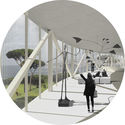
Emphasizing a diverse combination of ecological, infrastructural and urban programs in their envisioned design, Istanbul and Madrid-based design practice Openact Architecture has been named the winner of the Bandirma Park Competition, which invited ideas to “introduce Bandirma to the world."
Titled ‘A Path of the Fields’, the winning proposal presents a layered approach to the revitalisation of a former military and industrial brownfield in the industrial Turkish city of Bandirma.
The area is defined by Openact as both “an open, interactive, collective and productive focal point locally and regionally” and “an idea factory in the city of factories”, allowing for the exchange of ideas between the public and professionals. By centering the park around a Design and Research Institute, the intent is to create an environment that will strengthen Bandirma’s socio-economic standing, and offer a new hub for the city’s future, while seamlessly integrating into the natural ecological identity.


Extending the site’s present east-west conduits, the park embraces the urban fabric and provides varying degrees of connected urban and park programs, with a 5-star hotel and retail areas on the westerly side, and a 4-star hotel towards the east. Embedded within the landscape, these buildings cause minimal interruption in the surrounding topography and are used as public platforms, replacing the land they occupy and serving as thresholds into the park.
In order to resolve the lack of a continuous waterfront, as a result of the city’s prominent industrial sector, the existing port is to intended to be repurposed to accommodate a maritime museum and marine research center, reaffirming the design’s ambition for a permanently public hub.


Instead of a park as enclosed “arcadia”, the project proposes the design park as an urban form that emerges from its territorial surroundings and networks the park with the existing urban infrastructure to generate strong connections with the city, explained the design team.
An uninterrupted promenade creates circulation paths between the various available programs and allows for experiences and interactions while integrating the institute into the park as a landscape element. The institute itself, intended as a space for the arts, ecology, and education, offers unique vantage points and perspectives within its spaces, which include inclined auditoriums, outdoor workshops, lecture rooms, and a library.


According to the practice, each of these spaces is connected with its exterior in varying ways to allow for an experience of independent circulation or for a unified one. Therefore the experience of the path can alter constantly and will be open for endless intensifications, diversifications, and redistributions.
Preserving the site’s ecological character and using it as a means of sustainable production were also key considerations, and the proposed park incorporates bird-friendly wind farms to capitalize on Bandirma’s plentiful winds, offering a potential future energy generation source to support the city.


Other notable strategies such as rainwater management, re-habitation of local flora and fauna, reforestation, and productive agriculture, envision the park as the heart of ecological research, practices, and education.
‘A Path of the Fields’ was selected from 125 proposals from 27 countries around the world, by a jury comprised of Odile Decq of Studio Odile Decq, Louis Becker of Henning Larsen Architects, Professor Martin Rein-Cano of Topotek 1, Professor Dr. Celal Abdi Güzer of METU, and Professor Guenther Vogt of Vogt Landschaftsarchitekten.
To see the remaining winners and honorable mentions, check out the Bandirma Park Competition page, here.
News via: Openact Architecture.
How Schønherr is Transforming Aarhus with Experimental Urban Interventions





















